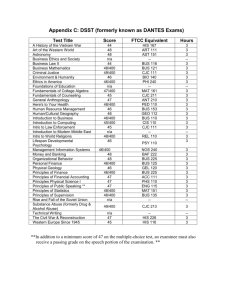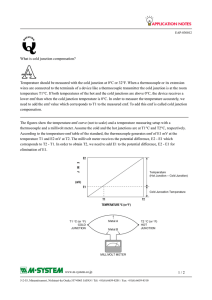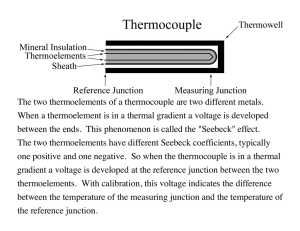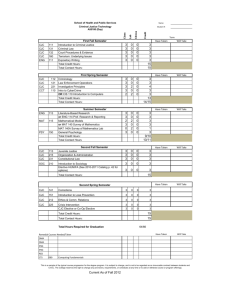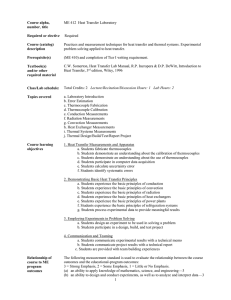Implementing Advanced Cold-Junction Compensation Techniques
advertisement
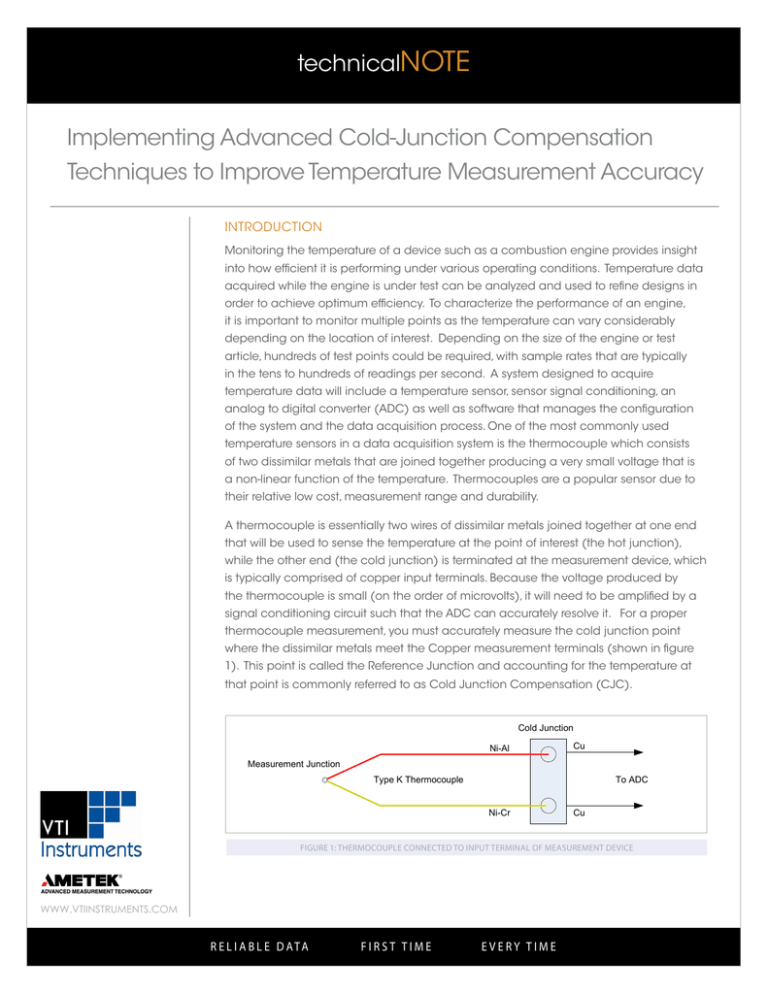
technicalNOTE Implementing Advanced Cold-Junction Compensation Techniques to Improve Temperature Measurement Accuracy INTRODUCTION Monitoring the temperature of a device such as a combustion engine provides insight into how efficient it is performing under various operating conditions. Temperature data acquired while the engine is under test can be analyzed and used to refine designs in order to achieve optimum efficiency. To characterize the performance of an engine, it is important to monitor multiple points as the temperature can vary considerably depending on the location of interest. Depending on the size of the engine or test article, hundreds of test points could be required, with sample rates that are typically in the tens to hundreds of readings per second. A system designed to acquire temperature data will include a temperature sensor, sensor signal conditioning, an analog to digital converter (ADC) as well as software that manages the configuration of the system and the data acquisition process. One of the most commonly used temperature sensors in a data acquisition system is the thermocouple which consists of two dissimilar metals that are joined together producing a very small voltage that is a non-linear function of the temperature. Thermocouples are a popular sensor due to their relative low cost, measurement range and durability. A thermocouple is essentially two wires of dissimilar metals joined together at one end that will be used to sense the temperature at the point of interest (the hot junction), while the other end (the cold junction) is terminated at the measurement device, which is typically comprised of copper input terminals. Because the voltage produced by the thermocouple is small (on the order of microvolts), it will need to be amplified by a signal conditioning circuit such that the ADC can accurately resolve it. For a proper thermocouple measurement, you must accurately measure the cold junction point where the dissimilar metals meet the Copper measurement terminals (shown in figure 1). This point is called the Reference Junction and accounting for the temperature at that point is commonly referred to as Cold Junction Compensation (CJC). Headline Cold Junction Ni-Al Cu Measurement Junction Type K Thermocouple To ADC Ni-Cr Cu FIGURE 1: THERMOCOUPLE CONNECTED TO INPUT TERMINAL OF MEASUREMENT DEVICE WWW.VTIINSTRUMENTS.COM R E L I A B L E D ATA FIRST TIME EVERY TIME technicalNOTE Getting accurate CJC measurements DID YOU KNOW? The EX1200 series is often the biggest hurdle that must be overcome in order to precisely measure/control record temperature measurements. subsystem is capable This technical note will focus on VTI of switching up to 576 Instruments design implementation channels of voltage or temperature in a single rack 1U mainframe. for cold junction compensation (CJC) used in the EX10XXA series of temperature measurement instruments Call to get a free demo today. (Figure 2) that has helped it become a FIGURE 2: EX1048A, 48 THERMOCOUPLE MEASUREMENT CHANNELS reliable tool for engineers who work in application spaces where highly accurate measurements are critical to the design process. When a thermocouple measurement device is subjected to a change in ambient temperature, a resultant change in thermal EMF is produced at the thermocouple instrument terminals resulting in a measurement error if the change at the cold junction is not measured properly. Compensating for that difference is necessary as the thermal EX1016A: 16 Channel Precision Thermocouple EMF at the input terminals has a direct impact on the accuracy of the measurement. This can be accomplished, by understanding what level of EMF is present at the cold junction and accounting for it during the conversion from voltage to temperature. However, radical changes in ambient temperature can make it difficult to get a true reading of the thermal EMF. Therefore, by embedding the cold junction in a significant thermal (metal) mass, it becomes less susceptible to rapid fluctuations in ambient temperature changes and provides a more stable reference which is needed for high EXLab: Full Featured, Turn-Key, accuracy measurements. Data Acquisition Software The most predictable method for accounting for the cold junction error is to implement an ice-water bath in series with the measuring thermocouple where the conditions are controlled to 0 degrees C. However, practically speaking, it is difficult to implement an ice-water bath and multiple reference junctions in large test fixtures. By measuring the cold junction or reference point accurately, we can eliminate the need to use an Icewater bath. A thermistor, which is the most widely used sensor for CJC implementations, can be reliably used to read the temperature of the reference junction point. ADVANCED CJC IMPLEMENTATION The accuracy of typical thermocouple instruments can vary significantly. There are many reasons for this, but common sources of error can be attributed to limited thermal mass resulting in susceptibility to ambient temperature variations, insufficient CJC sensor placement, or poor location of the input terminals with respect to adjacent heat sources such as power supplies. WWW.VTIINSTRUMENTS.COM R E L I A B L E D ATA FIRST TIME EVERY TIME technicalNOTE The bulk of the error in most implementations can be attributed to poorly designed CJC sensor circuits, and the input-to-CJC thermal coupling mechanisms. A measurement error will be generated when the temperature of the measured CJC is not exactly the same temperature as where the thermocouple wire makes connection with the copper input terminals. An isothermal block with a large thermal mass provides a means to keep the two termination points at the same temperature. A large thermal mass can minimize any rapid changes in temperature due to the change in the ambient temperature as it essentially acts as an insulator for the CJC sensor. Figure 3 below shows the EX10XXA series CJC isothermal interface. EX10XXA supports an isothermal block with significant thermal mass for every input channel to minimize the impact of rapid temperature changes, significantly reducing the measurement error generated due to the temperature difference between the termination points. Many temperature measurement devices implement a single CJC circuit to null out the error introduced by ambient temperature. However, ambient temperature within a measurement device can vary depending on air flow and internal ‘hot spots’. To account for temperature variations within the measurement device, the EX10XXA monitors twelve precision thermistors, one for every group of four thermocouple channels. Moreover, it features an internal calibration source that can be used to self-calibrate the unit prior to the beginning of a test to compensate for normal drift in the measurement circuitry and further maximize the accuracy of any thermocouple measurement over a wide ambient temperature range. FIGURE 3: CJC SENSOR WITHIN THE EX10XXA SERIES ISOTHERMAL INTERFACE WWW.VTIINSTRUMENTS.COM R E L I A B L E D ATA FIRST TIME EVERY TIME technicalNOTE Since the EX10XXA is a high channel count instrument, the fact that it incorporates multiple thermistors can eliminate gradients at different connection points and, thus, improves the accuracy of the measurement with typical measurements <0.2C, depending on thermocouple type and range. FIGURE 4: EX10XXA SERIES INTERNAL DESIGN There are three sections, the front panel with the isothermal block section, the data processing module section and the back section that contains the power supply and the controller. Each of the three sections is separated by a metal baffle plate. By placing the power supplies and the controller board at the rear of the instrument while placing the isothermal blocks with the input terminals in the front of the instruments (as shown in figure 4), there is a significant reduction in the impact from any internal heat source on the CJC thermistors. THE SOFTWARE DESIGN Since the goal is to measure the temperature at the CJC and correlate that to the temperature at the input terminals, the CJC should be measured at nearly the same time as each thermocouple input channel, further minimizing the impact of ambient temperature changes. The shorter the time difference between a CJC measurement and an input channel measurement, the more precise the compensation, and ultimately the reading, will be. EX10xxA CJC channels are measured with every scan, WWW.VTIINSTRUMENTS.COM R E L I A B L E D ATA FIRST TIME EVERY TIME technicalNOTE of an input channel and its associated CJC measurement, significantly increasing the reliability of the CJC measurement. EXTERNAL CJC While the EX10xxA series provides a unique implementation for compensating for the cold junction within the device, certain applications that are subject to extreme environmental conditions may dictate the need for a much larger thermal mass that is more resistant to rapid changes. The EX10xxA accommodates the use of external cold junctions that are maintained and measured by the user. In this case, the cold junction temperature in ºC is entered into the EX10xxA and enabled on a per channel basis. Furthermore, the EX10xxA allows the user to mix the use of internal and external CJC throughout the unit. THE PERFORMANCE With the advanced implementation for measuring the cold junction, the EX10xxA series is one of the most accurate thermocouple instruments in the market. The graph below shows a test result of a temperature drift test. Multiple channels with type K thermocouple were used in this test to constantly take a 1000C temperature measurement over a period of 117 days as the ambient temperature was cycled between 0 – 50 degrees C (figure 5). FIGURE 5: 117-DAY TERMPERATURE DRIFT TEST RESULT WWW.VTIINSTRUMENTS.COM R E L I A B L E D ATA FIRST TIME EVERY TIME technicalNOTE SUMMARY The cold junction compensation circuit is at the heart of an accurate thermocouple measurement engine. Even an isothermal block with significant thermal mass will slowly change temperature in phase with the ambient surroundings. Measurement error effects can be underestimated, or not correctly addressed. A quality temperature measurement instrument will incorporate a high-precision CJC mechanism, significant thermal mass and careful placement of parts that generate internal temperature gradients. The EX10xxA series supports isothermal masses, each of which is placed in the optimum location to avoid temperature gradients. The EX10xxA scanning mechanism ensures that the acquired thermistor CJC temperature is within 1 ms from the input channel data reading. Combined with the powerful end-to-end self-calibration feature, the EX10xxA has become one of the most accurate temperature instruments in the industry, with typical measurement accuracy of 0.2 degrees C. VTI Instruments delivers precision instrumentation for electronic signal distribution, data acquisition, and monitoring. The company continues to lead in the development of open standards for test and measurement along with scalable, modular products that maximize performance in a small footprint. With nearly two decades of experience primarily in the aerospace, defense and power generation markets, VTI helps customers maintain a competitive edge and preserve the integrity of their brand. WWW.VTIINSTRUMENTS.COM R E L I A B L E D ATA FIRST TIME EVERY TIME

